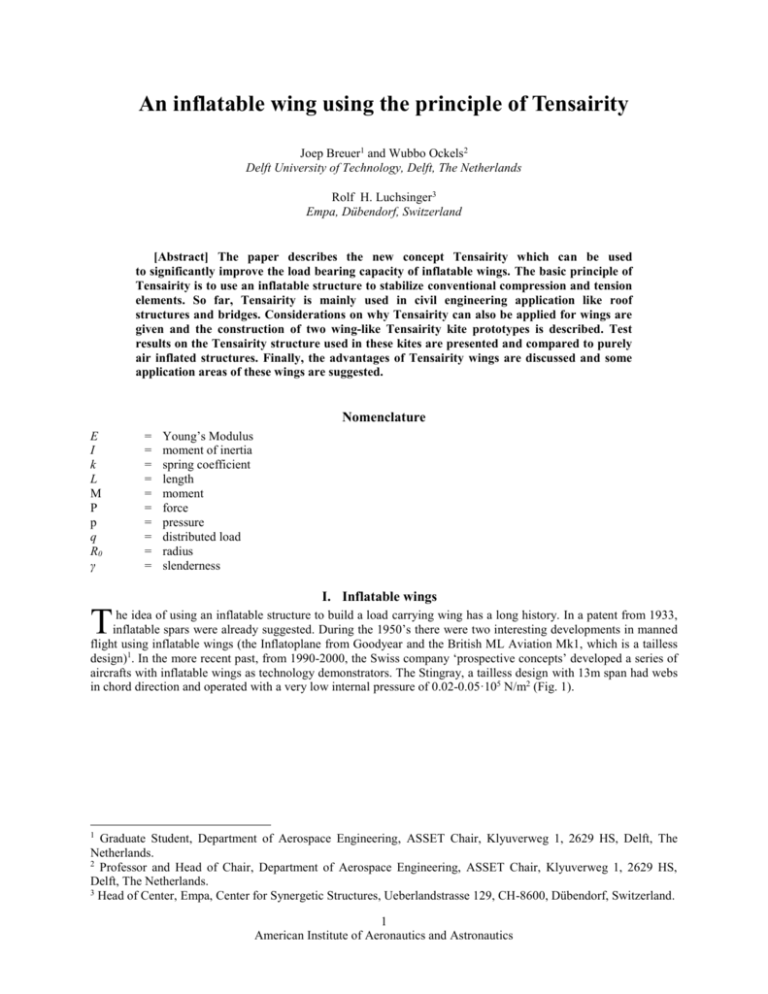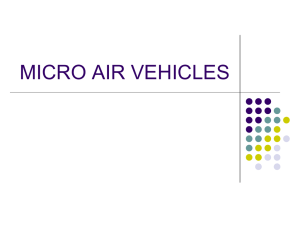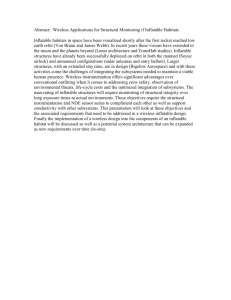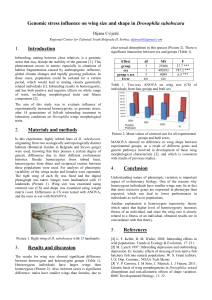Preparation of Papers for AIAA Technical Conferences
advertisement

An inflatable wing using the principle of Tensairity Joep Breuer1 and Wubbo Ockels2 Delft University of Technology, Delft, The Netherlands Rolf H. Luchsinger3 Empa, Dübendorf, Switzerland [Abstract] The paper describes the new concept Tensairity which can be used to significantly improve the load bearing capacity of inflatable wings. The basic principle of Tensairity is to use an inflatable structure to stabilize conventional compression and tension elements. So far, Tensairity is mainly used in civil engineering application like roof structures and bridges. Considerations on why Tensairity can also be applied for wings are given and the construction of two wing-like Tensairity kite prototypes is described. Test results on the Tensairity structure used in these kites are presented and compared to purely air inflated structures. Finally, the advantages of Tensairity wings are discussed and some application areas of these wings are suggested. Nomenclature E I k L M P p q R0 γ = = = = = = = = = = Young’s Modulus moment of inertia spring coefficient length moment force pressure distributed load radius slenderness I. Inflatable wings T he idea of using an inflatable structure to build a load carrying wing has a long history. In a patent from 1933, inflatable spars were already suggested. During the 1950’s there were two interesting developments in manned flight using inflatable wings (the Inflatoplane from Goodyear and the British ML Aviation Mk1, which is a tailless design)1. In the more recent past, from 1990-2000, the Swiss company ‘prospective concepts’ developed a series of aircrafts with inflatable wings as technology demonstrators. The Stingray, a tailless design with 13m span had webs in chord direction and operated with a very low internal pressure of 0.02-0.05·105 N/m2 (Fig. 1). 1 Graduate Student, Department of Aerospace Engineering, ASSET Chair, Klyuverweg 1, 2629 HS, Delft, The Netherlands. 2 Professor and Head of Chair, Department of Aerospace Engineering, ASSET Chair, Klyuverweg 1, 2629 HS, Delft, The Netherlands. 3 Head of Center, Empa, Center for Synergetic Structures, Ueberlandstrasse 129, CH-8600, Dübendorf, Switzerland. 1 American Institute of Aeronautics and Astronautics Figure 1. The manned inflated aircraft Stingray of ‘prospective concepts’. In later prototypes Pneuwing and Pneumagic, slender wings were realized with webs in span direction and a higher internal pressure in the order of 0.7·105 N/m2 (Fig. 2). The spacing between the webs is very small (in the order of a few centimetres) to accurately define the airfoil shape. Figure 2. The manned inflated aircraft Pneuwing (left) and Pneumagic (right) of ‘prospective concepts’. Recently the interest in inflatable wings is shifted to un-manned aircraft with examples as the NASA Dryden I2000 inflatable wing and the prototypes of the University of Kentucky in cooperation with ILC Dover. Inflatable surf kites can also be seen as inflatable wings although their definition of the airfoil is much cruder. The front of the airfoil is shaped by a single air tube (with an internal pressure of 0.5·10 5 N/m2) and the rest of the airfoil by a thin membrane behind this tube, tensioned by air struts in chord wise direction and the wind. The development in these kites is advancing quickly because the sport is gaining popularity. Most of the development follows from experiments by surf kite designers, although currently the scientific interest in kites is increasing for their possible use in energy production and ship propulsion. (refXXXXXXXX) One advantage of inflatable wings is that their flexibility gives them the capability to recover from gusts and crashes. Also it gives an opportunity to actively morph the wing for control. This flexibility also has a disadvantage because to get enough stiffness for a certain load capability a high pressure, thick wings, low aspect ratio or a combination of these is mostly necessary. A way to improve these aspects is to use the structural concept Tensairity. II. Tensairity The basic idea of Tensairity* is to combine an airbeam with conventional cables and struts to improve the load bearing capacity of inflatable structures. The name Tensairity, a combination of tension air and integrity, reflects the relationship with Tensegrity. Tensegrity, a concept developed by R. Buckminster Fuller, uses cables and struts respectively purely loaded in tension and compression. _____________________________ *Tensairity is a technology of the Swiss company Airlight Ltd developed in close collaboration with prospective concepts ag. The Tensairity research activities of ‘prospective concepts’ have been recently transferred to the Center for Synergetic Structures at Empa, the Swiss Federal Laboratories for Materials Testing and Research. 2 American Institute of Aeronautics and Astronautics This paragraph is for a large part a summary of [ref. 2. and ref 3.]. Tensairity adds to Tensegrity a pneumatic structure with a low internal pressure (typical pressures for Tensairity are in order of 0.1·105 N/m2) to stabilize the compression member against buckling. The basic Tensairity beam consists of a compression element, a low pressure airbeam which is tightly connected to the compression element and two tension elements which run from end to end of the compression element in a spiral way around the airbeam (Fig. 3). Figure 3. Basic Tensairity beam element. The slenderness of the structure can be defined as: L 2 R0 (1) With L and R0 defined as in figure 4. Figure 4. Forces in a Tensairity beam element. If a distributed load acts on the structure, the load is transferred by the pressure element (air beam) to the tension elements (cables). The force in the tension element is: 1 q L / 2 M qL L q L T 2 2 R0 2 R0 8 2 R0 8 2 (2) This force is transferred by the tension element to the compression element. For a compression member not only the stresses but also buckling phenomena have to be taken into account. For a compression element which is simply supported at its ends, the allowable compression load can by approximated by Euler buckling. And Euler buckling is quadratic dependent of the length of the element. But for a continuous elastic support, as is the case with Tensairity, where the compression element is supported by the air beam, the allowable compression load is independent of the length. This removes the need for support struts as with normal trusses. 3 American Institute of Aeronautics and Astronautics The allowable force with respect to buckling for an elastic foundation is [ref. 1.]: P 2 k E I (3) Where k is the spring coefficient of the foundation. The spring coefficient of the air beam in a Tensairity structure depends on the internal overpressure. This dependence can be approximated with: k p (4) P 2 p E I (5) This means that the allowable buckling load is: This load is in general higher than the Euler buckling load and the permissible load based on stresses, while only very low pressures are needed. An improved version of Tensairity is possible when a web is placed between the tension and compression element. This web will support the compression element. The spring constant in equation 3 can be taken equal to the Young’s modulus of the web material, which can be much higher than the spring constant in equation 4. This improves the stabilization of the compression element and reduces the necessary internal pressure even more. The main function of the pressure for the web Tensairity structure is not to stabilize the compression element, but to pretension the web. First realized applications of Tensairity are bridges and roof structures (Fig. 5). Light weight, fast and easy setup, new formal language and lighting options are properties of Tensairity which make this patented technology interesting for civil engineering applications. But Tensairity is a general concept for light weight structures and thus by no means restricted to civil engineering. It is the purpose of this work to investigate the potential of Tensairity for wing structures. Figure 5. First applications of Tensairity in civil engineering: test bridge with 8 m span (left) and roof over a parking area in Montreux, Switzerland with 28 m span. III. Theoretical weight comparison To get an idea of the weight of Tensairity compared to other types of structures (an air beam and a truss), theoretical comparison was made for their weight as a function of their slenderness γ (Eq. 1). This to get a better idea, in which type of wing structures Tensairity could give an advantage. Two types of Tensairity where considered, normal Tensairity and web Tensairity. Local and general buckling are taken into account, for the comparison between the different structures. The shape of both Tensairity and the truss are a spindle, like the roof structure of figure 5, the air beam however, has a cylindrical shape, because a spindle shaped air beam would buckle at the supports. As materials, high tension and high E-modulus carbon/epoxy are used for the struts and an aramid/PU composite for the membrane. This results in the following figure: 4 American Institute of Aeronautics and Astronautics Figure 6. Comparison of Tensairity with other structures as function of slenderness Clear is that the web variant of Tensairity is lighter than the normal variant of Tensairity, but at larger slenderness there is almost no difference between the truss and the Tensairity web spindle. For a wing type structure a high slenderness is especially interesting, because this makes it possible to make wings with a high aspect ratio and thin airfoils. But compared to an air beam, both Tensairity variants are much lighter. Therefore it was decided focus on the use of Tensairity in inflatable wings and compare a purely inflatable with a inflatable Tensairity wing. IV. Inflatable Tensairity Wings Several ways to insert Tensairity in a wing structure were investigated, but eventually a fully inflatable multi spar wing with two discrete Tensairity elements was chosen. The spars with Tensairity are placed at about 15% and 70% of the wing chord. The positions of the tension and compression elements of the Tensairity spars are indicated with the black dots in Fig. 7. In this way the advantages of Tensairity and an inflatable wing could be fully used. Figure 7. The Tensairity spars in the 4 m2 kite (MH 91 airfoil). To investigate the applicability of Tensairity in this type of structure, two kites were constructed. These kites enabled construction of prototypes in a short time and allowed to test Tensairity wings in flight without the need of power and/or radio control. The first full-scale model was a 2 m2 kite with a span of 3 m. This size would generate enough power to do measurements and is big enough to ease production. For production reasons the taper ratio was chosen equal to 1. A second prototype has a surface area of 4 m2 and a span of 4.5 m to generate more force and to make the period of the oscillations a bit larger (Fig. 8). 5 American Institute of Aeronautics and Astronautics Figure 8. The 4 m2 Tensairity kite. Because of the low internal air pressure in the order of 5000 N/m2 lightweight materials could be used, for the restraint and the outer skin, kite fabric (rip stop polyester or nylon with a thin PU coating) and for the bladders, thermoplastic polyurethane or Mylar. To fix the shape to the trailing edge of the wing low density foam is used. The Tensairity compression elements are carbon fiber kite tubes and the tension elements are made of Aramid/Vectran lines. These materials result in a weight of about 500-600 gr/m2, of which about 10 to 15 % is due to the tension and compression elements of Tensairity, depending on the size of the wing and the number of cells of the restraint. Both kites are designed to take up a maximum load of about 250 N/m2. The use of kite fabric meant that the restraints could be made with a simple sewing machine, resulting in fast and simple production. V. Experiments on a Tensairity kite structure To get a better insight into the loading capabilities of the kites, a test model of the front Tensairity spar with the two adjacent tubes was built, based on the dimensions of the small kite, and loaded in different configurations. The model was made with the same materials as the kites, only the bladder was of a slightly heavier polyethylene foil, due to availability. The length of the test model was 3 m, the radius of the tubes about 45 mm and the maximum height of the web 58 mm. The distributed load was approached by using 9 load introduction points. The test model was supported at the ends. The kites have an extra attachment point for lines at the middle of the structure to increase their loading capability. The complete test set-up can be seen in figure 9. Figure 9. The test set-up with the structure under load. The web Tensairity configuration was compared with a configuration with no tension and compression element (only the air tubes). They were tested with 4 pressures (0.025·105, 0.05·105, 0.075·105 and 0.1·105 N/m2). The results for Tensairity look as follows: 6 American Institute of Aeronautics and Astronautics Tensairity 0 deflection (mm) 0 5 10 15 20 25 30 35 -50 -100 -150 -200 -250 distributed load (N/m) 25 mbar 50 mbar 75 mbar 100 mbar analytical estimation Figure 10. Deflection of the test model with different pressures Clear is that with increasing pressure, the buckling point is postponed and the stiffness increased. The analytical estimation was made using the modified Castigliano’s theorem where only the tension and compression element with a fixed distance (infinitely stiff web) where considered. As can be seen the stiffness of Tensairity is quite close to this ideal case even at low pressures. Comparing the Tensairity structure with the air tubes gives the following graph. Comparison 75 mbar deflection (mm) 0 -50 0 5 10 15 20 25 30 35 -100 -150 -200 -250 -300 -350 -400 distributed load (N/m) Tensairity air tubes Figure 11. Comparison between Tensairity and the air tubes with a pressure of 0.075·10 5 N/m2 The stiffness and the maximum allowable load of the air tubes are, as expected, much smaller than for Tensairity at the same pressure. At other pressures the results are comparable. The increase in weight, using Tensairity, is very small compared to the increase in stiffness and allowable load. To show this the weights of the test model are given in the table below. Part Material Compression element Tension element Connection elements Total Tensairity Restraint Exel carbon tube 3.9x2.5 mm 2 mm Aramid line Aluminum Icarex kite fabric 31 gr/m2 Weight (gr) 34 % of total weight 10.8 5 12 1.6 3.8 86 16 27.3 7 American Institute of Aeronautics and Astronautics Polyethylene 70 gr/m2 Bladder Total weight 178 56.5 315 100 VI. Advantages of Tensairity wings The advantage of a Tensairity inflatable wing compared to a normal inflatable wing is that it is much stiffer while utilizing a lower pressure. The increased stiffness can be used to increase the span, for better performance or to increase the load bearing capacity of the wing. The lower pressure has consequences for the weight (use of lighter and cheaper materials) and the survivability. In case of a leakage it is much easier to compensate for the damage with a small pump, while still keeping structural rigidity and on the spot repairs are possible with simple methods. A disadvantage is that the wing can not be deployed by simple inflation due to the rigid compression elements. The set up requires some small assembly by inserting the compression elements in their pockets. Since the rigid elements are placed inside the wing and thus protected by an aircushion, the wing has a good crash resistance. The ability to flex under gust and overloads of a Tensairity wing is slightly less compared to a normal inflatable wing due to the presence of the rigid compression elements, but this is compensated by the higher allowable load. VII. Application Areas for Tensairity wings The application area of a Tensairity inflatable wing is very wide. It could be used in Ultra Light aircraft like the Pneuwing of ‘prospective concepts’, or hang-gliders like the Pneumagic. It would also be very interesting for small UAVs like the ones developed by ILC Dover and the University of Kentucky4-7, which have a comparable restraint shape. Currently the research is mainly focused on kites, because the L/D of a Tensairity kite is at least twice as high as in current kites. This makes the Tensairity kite interesting for use as a high altitude record kite (research on this subject was conducted at the faculty of aerospace engineering as part of an ESA project8-9) or as part of a wind power plant (Laddermill10). 1Brown, G., Haggard, R., Norton, B., Inflatable structures for deployable wings. Vertigo, Inc. AIAA-2001-2068. R.H., Pedretti, A., Pedretti, M., Steingruber, P., ‘The new structural concept Tensairity: Basic principles’, Progress in Structural Engineering, Mechanics and Computation, A.A. Balkema Publisher , London, 2004. 3 Luchsinger, R.H., Pedretti, A., Steingruber, P. & Pedretti, M., ’Light weigth structures with Tensairity. In Motro, R. (ed.), Shell and Spacial Structures from Models to Realizations, Editions de l’Espérou, Montpellier, 2004. 4Cadogan, D, Smith, T., Lee, R., Scarborough, S., Graziosi, D., “Inflatable and Rigidizable Wing Components for Unmanned Aerial Vehicles,” AIAA No. AIAA-2003-6630, 44th AIAA/ASME/ASCE/AHS/ASC Structures, Structural Dynamics and Materials Conference, Norfolk, VA, April 2003. 5Simpson, A., Santhanakrishnan, A., Jacob, J., Lumpp, J., Cadogan, D., Mackusick, M., Scarborough, S. ‘Flying on air: UAV flight testing with inflatable wing technology’. AIAA-2004-6570 AIAA 3rd”Unmanned Unlimited” Technical Conference, Workshop and Exhibit, Chicago, Illinois, September 2004. 6Simpson, A., Jacob, J., Smith, S., “Inflatable and Warpable wings for Meso-scale UAVs,” AIAA 2005-7161, Infotech@Aerospace, Arlington, Virginia, September 26-29, 2005 7Cadogan, D.P., Scarborough, S.E., Gleeson, D., Dixit, A.,“Recent Development and Testing of Inflatable Wings,” AIAA2006-2139, 47th AIAA/ASME/ASCE/AHS/ASC Structures, Structural Dynamics, and Materials Conference and 14th AIAA/ASME/AHS Adaptive Structures Conference, Newport, Rhode Island, May 1-4, 2006 8Veldman, S.L., Vermeeren, C.A.J.R., Bersee, H.E.N., Bergsma, O.K., Conceptual design of a high altitude kite, Faculty of Aerospace Engineering, Delft University of Technology, AIAA-2002-1735. 9Breukels, J.,”KitEye: work packages 3 to 8,” internal report, faculty of aerospace engineering, Delft University of Technology, Delft, 2005 10Lansdorp, B., Ockels, W.J., 2005, Design of a 100 MW laddermill, 7th World Congress on Recovery, Recycling and Reintegration, R’05 conference proceedings, Beijing, China. 2Luchsinger, 8 American Institute of Aeronautics and Astronautics







